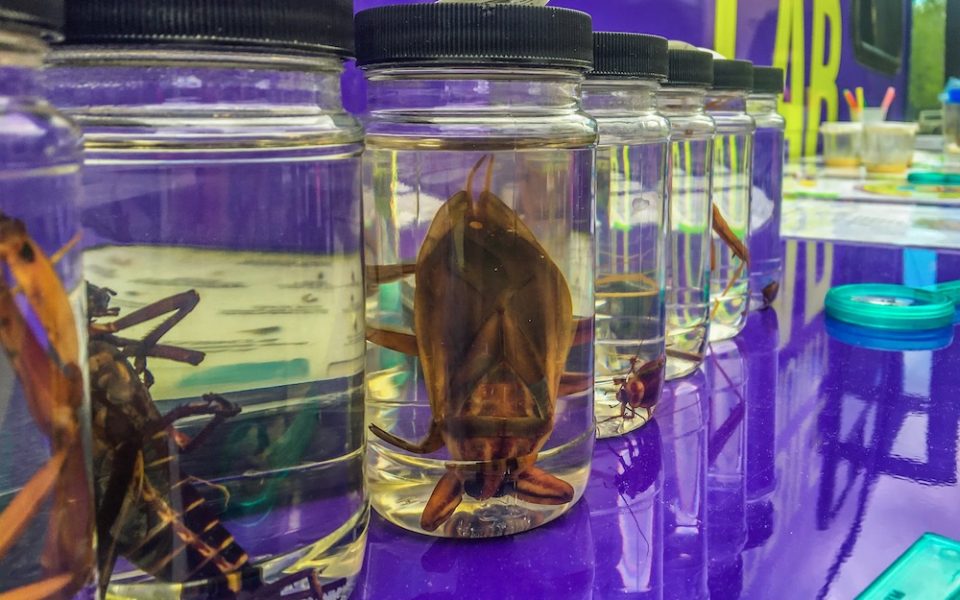A speckled butterfly floats in suspended animation inside a liquid-filled jar. The jar sits among others in a row, lined up on the shelf attached to the purple bus parked in front of the Greensboro Science Center. A young man leans in closer to one, examining the large beetle preserved inside.
The display makes up one portion of High Point University’s Mobile STEM Lab, which extends past the bus itself. Tables set up with buoyancy experiments and a telescope beckon visitors to the center before they reach the front door on a Saturday morning, setting the collaborative Science Extravaganza in motion.
The event plays a role in the annual North Carolina Science Festival, an annual statewide spree of STEM-related activities. Martha Regester, vice president of education at the center, stops at a table demonstrating beekeeping equipment. She pulls out a slat of a bee box to reveal not honeycomb, but posters with facts and figures about pollinator behavior. Aside from the science center’s offerings, community partners section off areas of the building to engage with audiences.
“We’ve got a really rich resource of science right here in the Triad,” Regester says.
Microscopes line the bus’s interior, as visitors examine the lattices of leaves and the patterns of insects in chrysalis. Veronica Segarra, assistant professor of biology at High Point University, feels that interactive elements make STEM more wide-reaching.
“We don’t all have access to the tools of science,” Segarra says.
Down a spiral staircase inside the center, a massive pendulum sways to keep the time. Around its gravity-regulated swing, NC A&T University hosts a medley of nanotechnology demonstrations.
A student from the engineering program squirts water onto a khaki-colored fabric. Rather than soaking into the cloth, the droplets gather together and slip right off, leaving it dry.
Salil Desai, an engineering professor, explains that nanotechnology takes the form of a waterproof coating. A passing man grabs the fabric, feeling for himself that the fabric remained dry.
“Its impact is only relevant,” Desai says, “if the public knows about it.”
A girl at height with the table exclaims that the 3-D printer in front of her is making a bracelet. Red plastic chains pop against the neon green tablecloth. A teen holds a magnet to a dollar, his eyes widening as the bill seemingly float towards it, due to the tiny bits of metal in the ink.

Down the hall, Alison Manka ushers families and guests into a showroom, her white lab coat reaching near the floor. As people file in, filling the rows of chairs while others lean against the wall, she steps up on stage for a scientific performance.
“A lot of these things,” Manka says, “are experiments you can’t do at home.”
She gestures to a metallic sphere that should conduct electricity into someone’s hair. Manka invites a small girl up front, asking her to place a hand on a gray orb twice the elementary-schooler’s size. She steadily positions her fingers on it, pushing her palm down when she realizes it won’t shock her. Manka flips the switch and slowly individual strawberry-blonde strands on the girl’s head begin to stand. She grips a mirror with her free hand and her jaw drops as her hair heightens.
After the girl steps offstage, Manka opens a cooler to show off dry ice, as nearly unanimous hands raise to be a part of the next experiment. She places the dry ice in a blue bowl, covering the top with soap. A bubble expands slowly, iridescent steaks enveloping the gas inside. When it pops, silvery carbon dioxide spills out over the black table.
A line forms as Manka hoses the CO2 gas through a soapy wand, creating a more palpable version of bubbles, heavier than their run-of-the-mill counterparts. Audience members of all ages rush up, putting on gloves to protect their hands, but Manka ensures the youngest ones get to experience science first-hand. A toddler holds her covered hands out, and Manka smiles as a fog-filled bubble plops out into her tiny grasp.
“Get ’em hooked while they’re young,” Manka laughs.
The Greensboro Science Center is located at 4301 Lawndale Drive. For other events and more information, visit their website here.
Join the First Amendment Society, a membership that goes directly to funding TCB‘s newsroom.
We believe that reporting can save the world.
The TCB First Amendment Society recognizes the vital role of a free, unfettered press with a bundling of local experiences designed to build community, and unique engagements with our newsroom that will help you understand, and shape, local journalism’s critical role in uplifting the people in our cities.
All revenue goes directly into the newsroom as reporters’ salaries and freelance commissions.


Leave a Reply